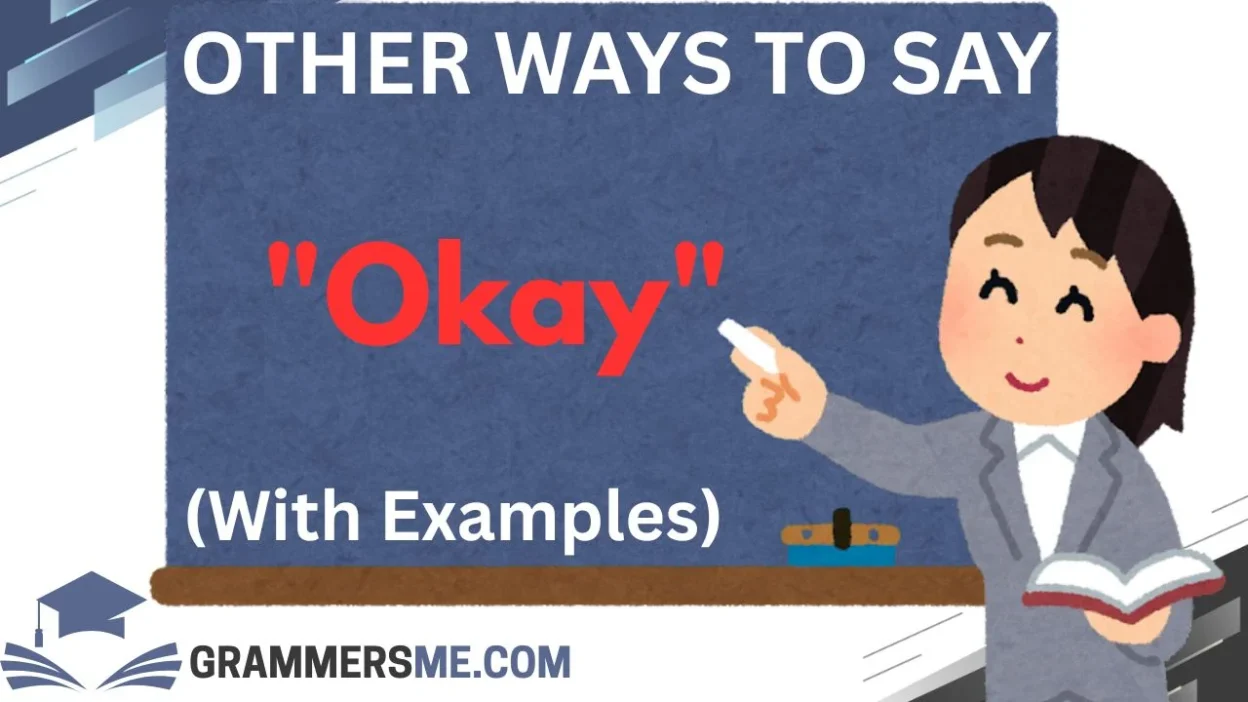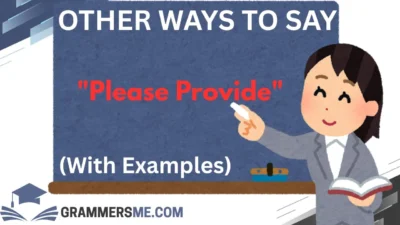Effective communication is an essential part of any professional interaction, and sometimes, the simple word “okay” just doesn’t cut it. Whether you want to show empathy, be more formal, or make your message sound warmer, the right choice of words can make all the difference.
In this article, we’ll explore 30 professional alternatives to the word “okay”, helping you express yourself more thoughtfully and authentically. Each alternative will come with its own context, best-use scenarios, and examples to guide you in choosing the perfect phrase for any situation.
What Does “Okay” Mean?
Before we dive into the alternatives, it’s important to understand the typical use of the word “okay”. It’s a versatile word, often used to signal agreement, acceptance, or acknowledgment. However, overuse can sometimes make it sound impersonal or too casual in professional settings. Finding the right alternative can help you express the same sentiment with more nuance and warmth.
Is It Professional/Polite to Say “Okay”?
While “okay” is widely accepted in informal and even some formal contexts, it’s not always the best choice for professional communication. In highly formal situations, such as business meetings, client interactions, or when dealing with sensitive matters, more thoughtful and considerate alternatives are recommended. It’s about striking the right tone and ensuring the recipient feels valued and heard.
1. Understood
Meaning: You acknowledge and comprehend the situation or request.
Explanation: This word conveys a clear understanding of the matter at hand, offering a respectful tone without seeming overly casual.
Scenario Example: “Understood, I will send the report by end of day.”
Best Use: When confirming instructions or directions in a professional setting.
Not Use: In situations where you need to add a personal touch or need to soften the response.
2. Got It
Meaning: Acknowledging that you understand or will take action.
Explanation: This phrase is more conversational but still polite and effective in informal work environments.
Scenario Example: “Got it, I’ll update the file and get back to you.”
Best Use: For casual communication with colleagues or in fast-paced environments.
Not Use: In formal settings or when addressing clients.
3. Absolutely
Meaning: Strong agreement or confirmation.
Explanation: A slightly more enthusiastic affirmation that conveys full support.
Scenario Example: “Absolutely, I will get on that right away.”
Best Use: When you want to show strong enthusiasm and commitment.
Not Use: In situations where a more neutral or cautious response is needed.
4. Certainly
Meaning: A polite and formal acknowledgment.
Explanation: Often used in professional settings, it conveys respect and agreement without being too casual.
Scenario Example: “Certainly, I’ll have the proposal ready by tomorrow.”
Best Use: In formal email responses or business meetings.
Not Use: In casual exchanges or when a simpler acknowledgment will suffice.
5. I See
Meaning: Indicates that you understand or have processed information.
Explanation: This phrase is empathetic and shows that you are fully engaged in the conversation.
Scenario Example: “I see, thank you for explaining. I will follow up with the team.”
Best Use: When listening actively and showing understanding, especially in team discussions.
Not Use: When you need to take action immediately after acknowledging.
6. Sounds Good
Meaning: An informal way to show agreement or approval.
Explanation: This phrase is often used to express approval in a friendly manner, though it’s best used in less formal settings.
Scenario Example: “Sounds good! Let’s meet at 2 p.m. tomorrow.”
Best Use: In relaxed work environments or casual conversations.
Not Use: When addressing superiors or in formal emails.
7. Noted
Meaning: A simple acknowledgment, typically in written communication.
Explanation: Often used in professional emails or messages to indicate that you’ve received and understood the information.
Scenario Example: “Noted, I will handle it first thing in the morning.”
Best Use: For formal, brief responses or in work settings where precision is key.
Not Use: In situations where you need to convey emotion or empathy.
8. Understood and Acknowledged
Meaning: A more formal way of stating you’ve both understood and accepted a point.
Explanation: This phrase adds an extra layer of professionalism, showing not only comprehension but also acceptance.
Scenario Example: “Understood and acknowledged, I will proceed accordingly.”
Best Use: When responding to instructions from superiors or clients.
Not Use: In casual settings or when a simpler phrase would suffice.
9. I’ll Take Care of It
Meaning: Assurance that the task will be handled promptly.
Explanation: This phrase conveys confidence and responsibility, assuring the other party that their request will be fulfilled.
Scenario Example: “I’ll take care of it. You can count on me to have it ready by the end of the day.”
Best Use: When you’re responsible for completing a task and want to show accountability.
Not Use: When you’re unsure about handling the task or if it’s not your responsibility.
10. Sure
Meaning: An informal, yet polite affirmation.
Explanation: “Sure” is a casual but acceptable way to express agreement or confirmation.
Scenario Example: “Sure, I’ll send over the updated version right away.”
Best Use: In informal conversations with coworkers or teammates.
Not Use: In formal or client-facing situations.
11. That Works
Meaning: This suggests that a suggestion or plan is acceptable.
Explanation: This is a friendly and flexible way to agree to a proposal or plan.
Scenario Example: “That works for me. Let’s finalize the details in the meeting.”
Best Use: When you are agreeing to a proposed solution or plan.
Not Use: When you need to express more enthusiasm or commitment.
12. I’ll Do That
Meaning: A direct, assertive commitment to completing a task.
Explanation: A straightforward confirmation that you will take responsibility for something.
Scenario Example: “I’ll do that as soon as I finish my current task.”
Best Use: When committing to handle a task or project promptly.
Not Use: When you need to be more deferential or show understanding first.
13. Of Course
Meaning: An affirmative response indicating that the request is natural or expected.
Explanation: This phrase adds a warm tone and can express eagerness to help.
Scenario Example: “Of course, I’ll make sure everything is ready for the meeting.”
Best Use: When you want to show enthusiasm and assurance.
Not Use: In formal or neutral situations where a more neutral response is preferred.
14. I’m On It
Meaning: A confident, proactive response indicating immediate action.
Explanation: This phrase gives a sense of urgency and responsibility.
Scenario Example: “I’m on it, I’ll have the updates to you by tomorrow morning.”
Best Use: When assuring someone that you are already working on the task.
Not Use: When you’re unable to commit to taking immediate action.
15. It’s Settled
Meaning: This indicates a decision or agreement has been reached.
Explanation: It shows that something has been confirmed and no further discussion is necessary.
Scenario Example: “It’s settled, we will meet on Friday at 10 a.m.”
Best Use: After a decision has been made or a conclusion reached.
Not Use: In situations where more discussion or input is needed.
16. Right Away
Meaning: Indicating that the task will be completed without delay.
Explanation: A prompt and efficient way to confirm you will act on the request immediately.
Scenario Example: “Right away, I will send the updated document.”
Best Use: When you’re able to act quickly and without hesitation.
Not Use: When you need time to prepare or respond.
17. Consider It Done
Meaning: A confident, positive affirmation.
Explanation: This phrase assures that the task will be completed, often with confidence.
Scenario Example: “Consider it done, I’ll make sure everything is in place by the end of the day.”
Best Use: When you want to reassure someone with certainty.
Not Use: In situations where you’re uncertain or don’t have control over the outcome.
18. You Got It
Meaning: A friendly and informal acknowledgment, showing that you will take care of something.
Explanation: This phrase is often used in more casual contexts to show willingness and readiness to complete a task.
Scenario Example: “You got it! I’ll have the report ready for you soon.”
Best Use: When interacting informally with teammates or close colleagues.
Not Use: In formal or professional settings.
19. I’m Happy to Help
Meaning: Expresses a willingness to assist.
Explanation: This phrase shows warmth and a helpful attitude, which is perfect for customer service or support roles.
Scenario Example: “I’m happy to help with that. Let me know if you need anything else.”
Best Use: When you want to express eagerness to assist others.
Not Use: When the task is outside your responsibilities or abilities.
20. All Set
Meaning: A phrase indicating everything is ready or in order.
Explanation: This phrase conveys preparedness and readiness.
Scenario Example: “All set for the presentation, I’ll be there at 3 p.m.”
Best Use: When you’ve completed all the preparations and are ready to move forward.
Not Use: When things are still in progress or need more work.
21. I Will Make It Happen
Meaning: A proactive and assured way to confirm commitment.
Explanation: This phrase conveys determination and confidence.
Scenario Example: “I will make it happen and have everything ready by tomorrow.”
Best Use: When you are committed to a specific outcome and want to reassure others.
Not Use: When you’re uncertain or don’t have control over the result.
22. Consider It Taken Care Of
Meaning: Indicates that something has already been addressed or is being handled.
Explanation: This shows initiative and gives a sense of completion or action.
Scenario Example: “Consider it taken care of. I’ve already reached out to the team.”
Best Use: When you want to reassure someone that their request is already being handled.
Not Use: When you’re not able to act on the request yet.
23. I’ll Handle It
Meaning: A simple, direct assurance that you will take responsibility for the task.
Explanation: This is a responsible, confident way to indicate that you will take care of something.
Scenario Example: “I’ll handle it. You don’t need to worry about a thing.”
Best Use: When confirming you are the person to take charge.
Not Use: When you are not the one responsible for the task or can’t complete it.
24. I Appreciate It
Meaning: Shows gratitude and acknowledgment of the other person’s request.
Explanation: This is more empathetic and polite than simply saying “okay,” showing that you appreciate the gesture.
Scenario Example: “I appreciate it, I’ll look into the matter and follow up with you.”
Best Use: When you want to express gratitude for someone’s request or offer.
Not Use: When a more neutral or assertive response is needed.
25. Let’s Do That
Meaning: Indicates agreement and enthusiasm for a proposal.
Explanation: This phrase conveys positive affirmation, and is often used in collaborative settings.
Scenario Example: “Let’s do that! I think it’s a great idea for the meeting.”
Best Use: When agreeing to a plan or idea, especially in teamwork or brainstorming sessions.
Not Use: When you need to discuss further before committing.
26. I Can Do That
Meaning: Shows readiness to take on a task or responsibility.
Explanation: This phrase is clear and confident, expressing a willingness to help.
Scenario Example: “I can do that, I’ll take care of it right now.”
Best Use: When volunteering to take on a task or project.
Not Use: When you cannot fulfill the task or lack resources.
27. I’m Good with That
Meaning: Signifies comfort and agreement with a proposal or idea.
Explanation: This is a slightly informal yet friendly way to express that you are in agreement.
Scenario Example: “I’m good with that, I’ll proceed as discussed.”
Best Use: In casual or relaxed professional environments where you want to express approval.
Not Use: When the conversation requires a more formal tone.
28. I Agree
Meaning: Directly indicating agreement or consent.
Explanation: This is a straightforward way to express that you are in alignment with a suggestion or statement.
Scenario Example: “I agree, that sounds like the best course of action.”
Best Use: When you want to explicitly confirm agreement without ambiguity.
Not Use: When you have reservations or need to offer feedback.
29. It’s Fine
Meaning: An indication that everything is acceptable.
Explanation: This phrase shows that something is agreeable and poses no issues.
Scenario Example: “It’s fine, I’ll get back to you as soon as I have the information.”
Best Use: When things are acceptable, and you don’t want to complicate the situation.
Not Use: When you need to assert more authority or confidence.
30. No Problem
Meaning: A casual acknowledgment indicating that there is no issue.
Explanation: This phrase shows that you are happy to comply without difficulty.
Scenario Example: “No problem! I’ll send it over right away.”
Best Use: In informal or friendly settings, especially when you’re willing to help.
Not Use: In formal interactions or when you want to convey more professionalism.
Conclusion
Finding the right words to express yourself professionally can have a huge impact on your relationships, productivity, and reputation in the workplace. The alternatives to “okay” in this article will help you elevate your communication style, making it more thoughtful and personal while maintaining professionalism.
Whether you’re confirming a task, expressing agreement, or offering reassurance, you now have a wide range of options to suit every situation.
FAQs
- What’s the best alternative to “okay” for formal settings?
- “Certainly” or “Understood” are great choices for formal communication, as they convey respect and clarity.
- “Certainly” or “Understood” are great choices for formal communication, as they convey respect and clarity.
- Is “Got it” too casual for work?
- “Got it” is suitable for informal or relaxed environments, but for more formal settings, use phrases like “Understood” or “Certainly.”
- “Got it” is suitable for informal or relaxed environments, but for more formal settings, use phrases like “Understood” or “Certainly.”
- When should I use “I’ll take care of it”?
- Use it when you are taking responsibility for a task and want to show that you are on top of things.
- Use it when you are taking responsibility for a task and want to show that you are on top of things.
- Can “Sounds good” be used in professional emails?
- Yes, “Sounds good” can work in professional emails, especially when communicating with colleagues in a less formal environment.
- Yes, “Sounds good” can work in professional emails, especially when communicating with colleagues in a less formal environment.
- What’s the most empathetic way to say “okay”?
- “I’m happy to help” or “I appreciate it” are more empathetic responses that show warmth and care.




